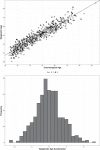Epigenetic Age Acceleration Assessed with Human White-Matter Images
- PMID: 28385874
- PMCID: PMC5426566
- DOI: 10.1523/JNEUROSCI.0177-17.2017
Epigenetic Age Acceleration Assessed with Human White-Matter Images
Abstract
The accurate estimation of age using methylation data has proved a useful and heritable biomarker, with acceleration in epigenetic age predicting a number of age-related phenotypes. Measures of white matter integrity in the brain are also heritable and highly sensitive to both normal and pathological aging processes across adulthood. We consider the phenotypic and genetic interrelationships between epigenetic age acceleration and white matter integrity in humans. Our goal was to investigate processes that underlie interindividual variability in age-related changes in the brain. Using blood taken from a Mexican-American extended pedigree sample (n = 628; age = 23.28-93.11 years), epigenetic age was estimated using the method developed by Horvath (2013). For n = 376 individuals, diffusion tensor imaging scans were also available. The interrelationship between epigenetic age acceleration and global white matter integrity was investigated with variance decomposition methods. To test for neuroanatomical specificity, 16 specific tracts were additionally considered. We observed negative phenotypic correlations between epigenetic age acceleration and global white matter tract integrity (ρpheno = -0.119, p = 0.028), with evidence of shared genetic (ρgene = -0.463, p = 0.013) but not environmental influences. Negative phenotypic and genetic correlations with age acceleration were also seen for a number of specific white matter tracts, along with additional negative phenotypic correlations between granulocyte abundance and white matter integrity. These findings (i.e., increased acceleration in epigenetic age in peripheral blood correlates with reduced white matter integrity in the brain and shares common genetic influences) provide a window into the neurobiology of aging processes within the brain and a potential biomarker of normal and pathological brain aging.SIGNIFICANCE STATEMENT Epigenetic measures can be used to predict age with a high degree of accuracy and so capture acceleration in biological age, relative to chronological age. The white matter tracts within the brain are also highly sensitive to aging processes. We show that increased biological aging (measured using epigenetic data from blood samples) is correlated with reduced integrity of white matter tracts within the human brain (measured using diffusion tensor imaging) with data from a large sample of Mexican-American families. Given the family design of the sample, we are also able to demonstrate that epigenetic aging and white matter tract integrity also share common genetic influences. Therefore, epigenetic age may be a potential, and accessible, biomarker of brain aging.
Keywords: aging; epigenetics; genetics; white matter integrity.
Copyright © 2017 the authors 0270-6474/17/374735-09$15.00/0.
Figures



References
-
- Benjamini Y, Hochberg Y (1995) Controlling the false discovery rate: a practical and powerful approach to multiple testing. J R Stat Soc Ser B 57:289–300.
-
- Boks MP, van Mierlo HC, Rutten BP, Radstake TR, De Witte L, Geuze E, Horvath S, Schalkwyk LC, Vinkers CH, Broen JC. Vermetten E (2015) Longitudinal changes of telomere length and epigenetic age related to traumatic stress and post-traumatic stress disorder. Psychoneuroendocrinology 51:506–512. 10.1016/j.psyneuen.2014.07.011 - DOI - PubMed
-
- Chen BH, Marioni RE, Colicino E, Peters MJ, Ward-Caviness CK, Tsai PC, Roetker NS, Just AC, Demerath EW, Guan W, Bressler J, Fornage M, Studenski S, Vandiver AR, Moore AZ, Tanaka T, Kiel DP, Liang L, Volkonas P, Schwartz J, et al. (2016) DNA methylation-based measures of biological age: meta-analysis predicting time to death. Aging (Albany, NY) 8:1844–1865. 10.18632/aging.101020 - DOI - PMC - PubMed
Publication types
MeSH terms
Grants and funding
LinkOut - more resources
Full Text Sources
Other Literature Sources
Medical
